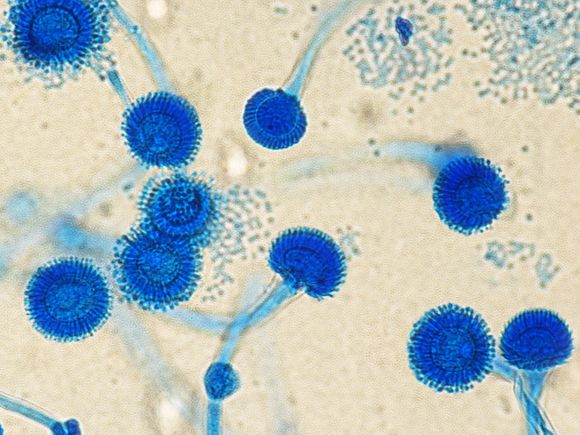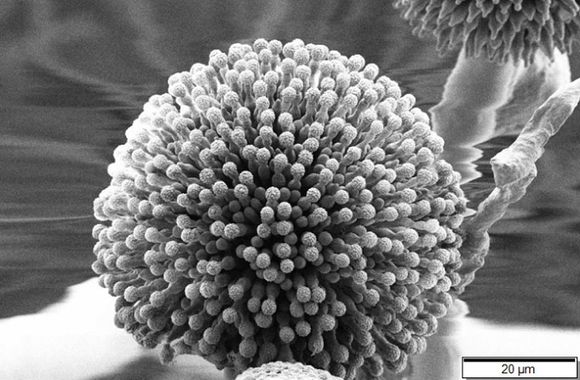Author: Rositsa Тashkova, Master of Molecular Biology and Microbiology
The season of allergies is long gone, but we still have a runny nose, watery eyes, or cough, for no obvious reason. Seems that it is very likely that we have an allergy to household dust or mold, and it is time to take a good look at all possible sources of these allergens.
What are mold and mildew?
Molds and well-known black mold are microscopic fungi, and like other fungi, they reproduce through spores. We can safely imagine the spores as miniature seeds that float through the air until they fall into an environment conducive to their development. And this for the fungus means - moisture and nutrients.
In some species, spores are carried by dry air and currents, and in others - by droplets of moisture in the air.
Mold and mildew are an important part of the circle of life in living nature, as they break down dead organic matter and thus make the substances "locked" in it accessible to other living organisms. For example, by breaking down the fallen leaves, the useful substances from them are returned to the soil, and the surrounding plants can make use of them.

Unfortunately, microscopic fungi do not distinguish between nature and our home, and if the conditions at home are suitable, they will become our roommates without a doubt.
Few people know that mold and mucor are two different things, but we can learn to easily recognize them without a microscope:
- At the beginning of its development, mucor forms a white structure of air hyphae (threads), which is very similar to cotton. After a while, black dots begin to form on the tips of these strands - these are small bags in which black spores ripen and wait for the moment they will be released.
- Molds form colored colonies that look more like a relief adhesive of blue, green, beige, or another color. The spores in mold are not in bags, but form directly on the tips of something like small "twigs".
When mucor and mold become a problem
Besides the aesthetically unpleasant damage that mold and mold cause to walls and other affected surfaces, their spores are those that cause allergic reactions and even asthma in some people.
One of the most common dangerous molds is Aspergillus niger, the color of which is black. It is often found on onions. It can cause otomycosis if it gets into and develops in the ear canal, which causes pain and leads to temporary deafness.
Spores of another species of the genus Aspergillus - Aspergillus fumigatus - can endanger the lives of people with compromised immune systems by causing aspergillosis [ref. 1]entering the lungs.

It is also known that the consumption of molded foods (when it is not a noble mold) is also dangerous, since microscopic fungi secrete toxins in food that can damage the liver and other organs. Toxins dissolve well especially in liquid foods, so burying the mold from the jam or yogurt and cutting out the tomato does not solve our problem - if we have allowed fungi to develop on them, we should throw them away, as they are no longer edible.
What are the symptoms of allergy and how to weaken them
Symptoms of allergy to mold and mold are very similar to those of hay fever [ref. 2]: stuffy or flowing nose, laity and itching in the eyes and nose, sneezing, and even skin manifestations such as dry and flabby skin.
If the spores reach the lung, the allergic reaction can also manifest itself there in the form of asthma.
Unfortunately, the only way to combat this allergy and limit our contact with mold spores and mold. In nature, their amount is greatest in the summer months and autumn.
If we like to work in the garden, this can also expose us to these spores. Therefore, it is advisable to wear a mask when mowing grass, planting, digging or collecting the leaves in the autumn. [ref. 3] Molds develop perfectly on rotting and moist plant waste, so we need to handle them carefully, especially if we suffer from an allergy.
Unfortunately, fighting mold at home is not at all easy, especially when we can’t properly remove moisture. It can be due to leaks in the building itself, poor ventilation of the premises. Even our attempts to make our home more energy efficient by placing aluminum or PVC joinery or insulation on the walls can lead to increased humidity in the home and condensation on windows and walls.
What to do to reduce the danger of developing mold at home
Several steps can reduce the danger of developing mold and mold in the home:
- If there are leaks - do all you can to remove them;
- To ventilate the place as often as possible, including in winter;
- Do not put large furniture (cabinets, sections, libraries) to external walls, and if this is not possible - leave enough distance between the wall and the piece of furniture to have air circulation;
- In case of probable condensation and moisture, leave the wardrobes open from time to time, bring the clothes forward, so that they are not at the back of the wardrobe;
- To ensure moisture removal in rooms where washing machines and dryers operate - let fresh air in after each washing and drying and use dehumidifiers in the room. After each laundry, it is important to absorb the water from the tire around the opening of the washing machine, as well as wash and dry the detergent drawer - mold and mildew also develop there;
- If possible, do not dry laundry indoors;
- You can also resort to the use of air purification devices - some of them are combined and also capture excess moisture. It should be considered that both humidifiers and dehumidifiers have water containers, which can also become a mold kennel - it is necessary to empty and clean them thoroughly at least 2 times a week;
- Moisture in the bathroom is also a problem, and using a fan to take it away is an important but insufficient measure. It is necessary to ventilate the bathroom after bathing. Several holes can be installed at the bottom of the door, and after bathing the moisture can be removed from the walls with a window cleaning tool. Joints should be cleaned with detergent at least once a month, and the curtain should be left to dry - it often gets mold;
- Air conditioner filters must also be serviced as prescribed, that’s usually done by a technician.
These rules apply not only to people suffering from allergy, but to anyone who wants to have a healthier environment and cleaner air in their home.
